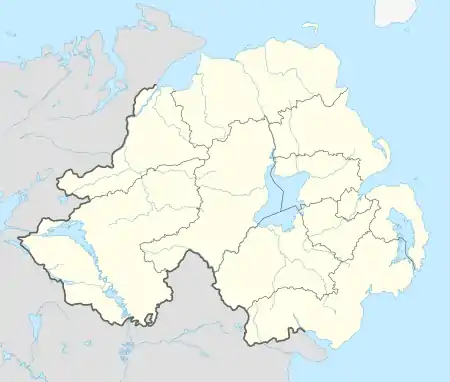Derrygonnelly
Derrygonnelly (from Irish: Doire Ó gConaíle, meaning "O'Connelly's oak grove")[2][3] is a small village and townland in County Fermanagh, Northern Ireland. Near Lower Lough Erne, the village was home to 680 people (at the 2011 Census) and dates to the Plantation era.[3] It is situated within Fermanagh and Omagh district.
| Derrygonnelly | |
|---|---|
 Derrygonnelly Location within Northern Ireland | |
| Population | 594 (2001 Census) |
| Irish grid reference | H1215 |
| • Belfast | 76 mi (122 km) |
| • Dublin | 97 mi (156 km) |
| District | |
| County | |
| Country | Northern Ireland |
| Sovereign state | United Kingdom |
| Post town | ENNISKILLEN |
| Postcode district | BT93 |
| Dialling code | 028 |
| UK Parliament | |
| NI Assembly | |
The village has a long history of Irish traditional music and each year in early October there is a celebration of local talent in memory of musicians Eddie Duffy and Mick Hoy.[3] Musicians come from all over Ireland and from further afield to enjoy this festival which bases itself in any of Derrygonnelly's four pubs.
Transport
Ulsterbus route 59 provides several journeys a day to/from Enniskillen via Monea and The Graan. There is no Sunday service.[4]
History
Derrygonnelly is of ancient origin taking its name from doire or grove of the O'Connelly's it was a site of inauguration for Irish kings. Derrygonnelly was planted by General Archdale as a Plantation town. The area hosted fairs from the late 18th century but the village itself only really developed as late as 1812 when the long, flat main street was built along the Sillees River.[3] The main road to Enniskillen was known as the Famine Road as it was made during the 1846 famine as a relief scheme.[3]
The townland of Derrygonnelly contains two Scheduled Historic Monuments: Dunbar manor plantation castle, grid ref: H11871 52475 and a 17th-century church, grid ref: H1208 5240.[5]
Places of interest
The old creamery in Derrygonnelly has been converted into a residential environmental education centre, Tir Navar, run by the Field Studies Council.[3][6]
Approximately one mile to the northwest of the village are the ruins of Carrick Church; built by Gilbert O'Flanagan in 1483 "In Honour of God and Mary". The church's graveyard was used by the locals until around 1930. Also just north of the village is a small ruined church that combines medieval and Renaissance features, built in 1627 by Sir John Dunbar. His coat of arms is located over the doorway. Other 17th-century ruins in the nearby area include Monea Castle and Tully Castle, the latter having been sacked and burned by Rory Maguire on Christmas Day during the 1641 rebellion. As well as Lower Lough Erne to the north, Derrygonnelly is surrounded by small lakes and is split by the Sillees River, which is popular with canoeists.
4 miles (6.4 km) outside the village towards Garrison is Correl Glen and Lough Navar Forest Drive. The Forest Drive is a 7-mile (11 km) walk through Lough Navar Forest and has a viewpoint at the top which overlooks Lower Lough Erne, as far as the Donegal coast to the west and the Sperrin Mountains in County Tyrone to the north and east. On the opposite side of the road lies Correl Glen, which features another walking route, with some small waterfalls near the entrance.
Education
Derrygonnelly has two primary schools:
- St Patrick's Primary School
- Derrygonnelly Controlled Primary School
Gaelic sports
The local Gaelic football team are the Derrygonnelly Harps (Doire Ó gConaile na Cláirsigh) who play on their home ground of Canon Maguire Park. The club was founded in 1924. The team have won three New York Gold Cups (the County Championship), one in 1995, 2004 and the most recent in 2009. There are teams fielded at every level of men's and ladies' football.
2001 Census
Derrygonnelly is classified as a small village or hamlet by the NI Statistics and Research Agency (NISRA) (i.e. with a population of between 500 and 1,000 people). On Census day (29 April 2001) there were 594 people living in Derrygonnelly. Of these:
- 23.6% were aged under 16 and 19.7% were aged 60 and over
- 50.3% of the population were male and 49.7% were female
- 77.4% were from a Catholic background and 20.1% were from a Protestant background
- 4.0% of people aged 16–74 were unemployed.
For more details see: NI Neighbourhood Information Service
2011 Census
On Census Day (27 March 2011) the usually resident population of Derrygonnelly Settlement was 680 accounting for 0.04% of the NI total.[7]
- 75.88% belong to or were brought up in the Catholic religion and 20.15% belong to or were brought up in a 'Protestant and Other Christian (including Christian related)' religion; and
- 19.85% indicated that they had a British national identity, 46.62% had an Irish national identity and 34.85% had a Northern Irish national identity*.
References
- White Island and Inishmacsaint (Ulster-Scots translation) Archived 2011-08-30 at the Wayback Machine Department of the Environment.
- Placenames Database of Ireland
- "Your Area: Derrygonnelly". Culture Northern Ireland. Archived from the original on 9 June 2008. Retrieved 30 November 2009.
- http://www.translink.co.uk/Services/Ulsterbus-Service-Page/Routes--Timetables/All-Timetables1/Ulsterbus-Service-59-Outbound/
- "Scheduled Historic Monuments (to 15 October 2012)" (PDF). NI Environment Agency. Archived from the original (PDF) on 26 October 2013. Retrieved 13 November 2012.
- "Tir Navar". Northern Ireland Tourist Board. Retrieved 30 November 2009.
- "Census 2011 Population Statistics for Derrygonnelly Settlement". NINIS. Retrieved 21 December 2019.